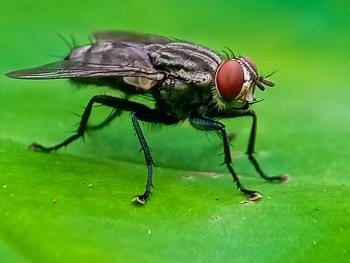
Hypomagnesemic tetany in ruminants (Proceedings)
Ruminants are uniquely susceptible to hypomagnesemic tetany (HMT) caused by a variety of factors.
Ruminants are uniquely susceptible to hypomagnesemic tetany (HMT) caused by a variety of factors. Grass tetany, wheat pasture tetany, lactation tetany, and milk tetany are just a few of the terms used to describe HMT. A marked decrease in the extracellular fluid (ECF) concentration of magnesium (Mg) is the primary metabolic abnormality. The low ECF Mg or low Mg/Ca ratio in the ECF will potentiate the release of acetylcholine at the neuromuscular junction and is thought to be the cause of the tetany.
The factors thought to be important in causing HMT are:
1. Lactation: cows at the peak of lactation are at greatest risk. There is a substantial amount of Mg that is secreted into milk. Mg is in milk at about one-tenth the amount of Ca or P.
2. Potassium in feed and/or soil: potassium (K) interferes with Mg absorption in both the plants and in the ruminants. Many forages are high in K, particularly lush cereal pastures such as wheat, barley, and oats. Using the following ratio: K ÷ Ca + Mg; Dutch researchers have shown that when this value is >2.2 there is an increasing risk of HMT.
3. Nitrogen fertilization: the use of ammonia/ammonium based fertilizers increase the susceptibility to HMT. This is due to increased dietary crude protein and K; both of which interfere with Mg absorption in the ruminant and lead to an increased risk of HMT. Also, NH4+ competes with Mg uptake by the plant and thus lowers the Mg content in the forage diet of ruminants.
4. Stress or fasting: fasting, anorexia, and/or stress can cause decreases in serum Mg and ECF Mg that may not return to normal for several days. Epidemics of HMT commonly occur in lactating beef cows on foothill pastures in California following spring storms.
5. Milk diets in calves: whole milk and some milk replacers are Mg deficient. Long term (> 2 months) milk diets without access to other Mg sources can be associated with episodes of tetany in calves.
6. Rations high in fat: fat tends to form Mg soaps and decreases Mg absorption. This can be a practical consideration in some dairy rations.
HMT clinical syndromes
Grass tetany. Associated with grazing lush pastures by cows early in lactation. The cows, and rarely the calves, are found dead or having convulsions. The etiologic factors include:
Low Mg content of pasture forage
b. High K content pasture forage
c. High crude protein content (ruminal NH3 and NH4+ concentrations)
d. Bad weather, stress, fasting
e. Lactation losses—Ca and Mg in the milk
f. Organic acids (citric, trans-aconitic, etc) which may bind Mg
g. Ammonia fertilization of irrigated pastures
h. Combinations of the above factors
Wheat pasture tetany. Young, rapidly growing cereal grain pastures (wheat, barley, oats) with low Mg content and very high K and crude protein levels. Mg absorption is interfered with by all of these factors.
Milk tetany in calves. Whole milk diets in some dairy and veal calves for prolonged periods of time or in beef calves nursing cows predisposed to HMT are most at risk. Diarrhea often precipitates the onset of tetany.
Transport tetany. Stress and fasting associated with transport can precipitate HMT.
Low Mg diets. Some diets are extremely low in Mg content such as dry winter pasture or low quality roughage. These diets can cause frank Mg deficiencies and HMT.
HMT clinical signs
HMT is often peracute and the animals are simply found dead with perhaps evidence of paddling and opisthotonos (marks on the ground and bruising of the head, ears, and orbit) as the only evidence. Clinical signs when observed are progressive with the first signs being twitching of the ears, hyperesthesia, small muscle fasiculations, and irritability. Later, severe hyperesthesia, belligerent behavior, incoordination, recumbency, paddling, opisthotonos and death occur. Mild cases may recover spontaneously and episodes may recur. Bloat and aspiration pneumonia may complicate the clinical course
Differential diagnosis
Common differentials in California would include anything that causes sudden death or CNS signs, such as rabies, Redwater, anaplasmosis, and anthrax.
Diagnosis
In addition to hypomagnesemia, there is often a concurrent hypocalcemia, which can be seen in up to 80% of grass tetany cases. Wheat pasture tetany is characterized by hypomagnesemia, hypocalcemia, and hyperkalemia. After a violent convulsion the serum Mg level can briefly return to normal and it may be necessary to obtain a serum sample at another time.
Cattle and sheep are often hypomagnesemic for days to weeks prior to clinical signs of HMT and diagnosis or monitoring of the herd can be done: however, it should be noted that the stress of putting cows through the chute for sampling can precipitated HMT. At post mortem, serum Mg is not a reliable sample for diagnosis. For dead animals, the use of cerebrospinal fluid (CSF) or vitreous humor is preferred as these concentrations parallel the serum and other CSF levels at the time of death. CSF levels of 1.25 mg/dl or less and vitreous humor levels of <1.16 mg/dl are diagnostic of HMT. Vitreous humor samples can be obtained with a 3 ml syringe and 18 ga. Needle for up to 48 hours after death and still give diagnostically useful information. The CAHFS laboratory has a tetany panel that is a routine test for serum and other samples. CSF and vitreous samples are routinely run at CAHFS.
Treatment
Initial treatment is often via solutions containing 25% calcium borogluconate and 5% magnesium hypophosphite. Adjuncts include subcutaneous Mg (as 20% MgSO4 or 20% MgCl2) injections. Also, MgCl2 enemas (60 grams MgCl2 in warm water) are effective and can be administered by owners. MgSO4 enemas can be substituted. Since many of the affected cattle can be dangerously belligerent when clinically ill, the Mg enemas are very helpful therapy. Once the animal is stabilized, it is advised they be moved to a corral area, fed alfalfa hay and treated for another 3-4 days.
When presented with an outbreak, it is advised that the herd immediately be fed alfalfa hay (20+ pounds per cow per day). Do not attempt to move the cattle great distances when clinical cases are occurring.
To supplement lactating beef cattle at risk of HMT usually requires 1-2 ounces of MgO, MgCl2, (or less effective MgSO4) per cow per day. Sheep require about 1/3 ounce/head/day to aid in prevention of HMT. These supplements can part of salt mixtures, liquid supplements, or total mixed rations. Management constraints should be given top priority in planning successful prevention programs. It is important to remember that hypocalcemia is a major factor in causing HMT and Ca supplementation should be considered a high priority in supplementation. Also, NaCl aids Mg absorption so salt mixes have additional benefit in preventing HMT. One relatively inexpensive method of supplementing beef cattle involves a 1:1:1:1 mixture of salt:MgO:dicalcium phosphate:ground corn fed free choice to a consumption of 4-8 ounces per head per day.
Newsletter
From exam room tips to practice management insights, get trusted veterinary news delivered straight to your inbox—subscribe to dvm360.




